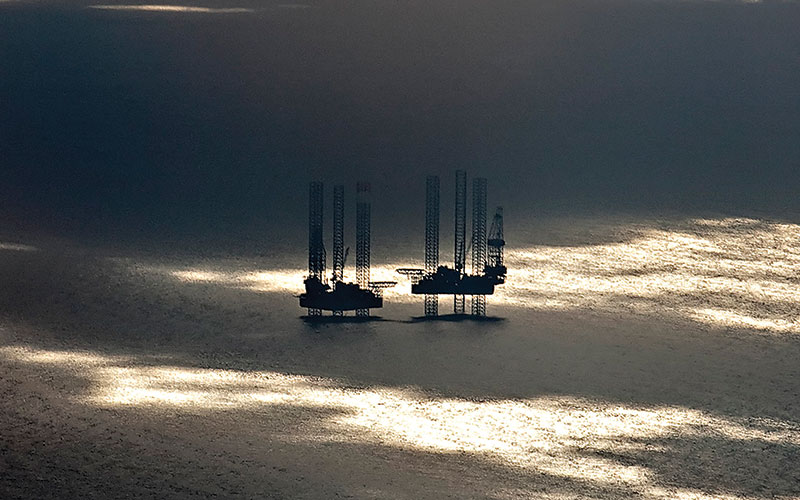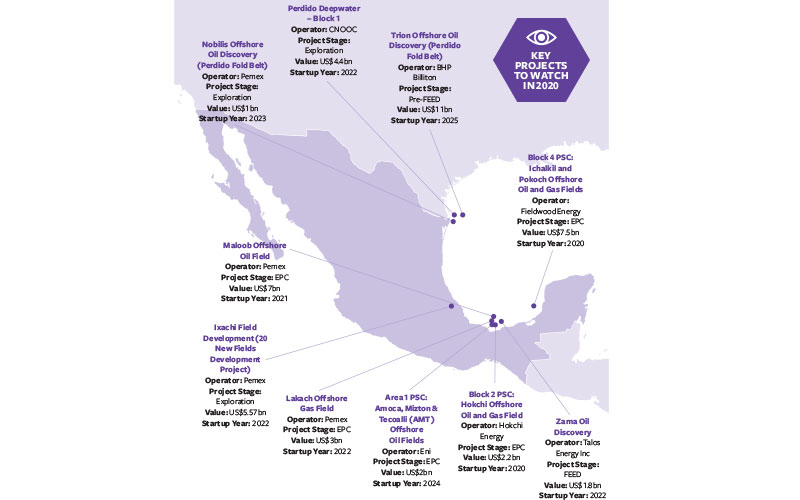Mexico still holds promise
Despite Mexico’s rollback of energy reforms, projects already agreed are moving forward. Opportunities abound but companies need to be ready now, writes EIC’s Amanda C Duhon

In an effort to address its declining oil production, Mexico’s previous administration, under President Enrique Peña Nieto, enacted Reforma Energética (Energy Reform) in 2013 – putting an end to the national oil company (NOC) Petróleos Mexicanos’ (Pemex’s) monopoly and opening the market to
private and international investment, while diversifying the Mexican economy.
Reforms bear fruit
Round Zero kicked off the Energy Reform by providing Pemex first right of refusal on developing assets. Pemex could thereafter farmout these assets into contracts and/or enter joint ventures with private international players to develop the asset. The private sector was then also able to enter the Mexican oil and gas market by bidding directly to the National Hydrocarbon Commission (CNH) for rights to develop assets not assigned to Pemex.
Mexico saw some real success between 2015–2018 through its three licensing rounds. Fourteen auctions resulted in 110 contracts being awarded across deepwater, shallow and onshore fields, and a total of US$148bn being committed, including three farmout awards. As of August 2019, the Mexican government had approved 642 wells worth more than US$36.4bn. The country now has over 70 international companies operating in-market across the oil and gas value chain.
Rollback to nationalisation
Mexico’s new energy market provided for market competition, investment, and improved efficiencies and operations. However, when the new president Andrés Manuel López Obrador (AMLO) – a staunch opponent of the Energy Reform – took office in December 2018, he was committed to returning more control of the energy sector to Pemex.
He cancelled Round 3.2 and 3.3 auctions and farmouts and delivered the Pemex 2019–2024 business plan to a lukewarm reception. In short, AMLO has promised that the renationalisation of Mexico’s oil and gas market will increase net oil production to 2.697MMbbl/d by the end of 2024, thereby reducing the country’s reliability on imports.
New revival plans
Under the business plan, rather than opening additional upstream auctions to foreign investors, AMLO insists Pemex go alone, with the option to take forward a new service contract scheme around production and profit-sharing called Integrated Exploration and Extraction Service Contracts (CSIEE).
This scheme puts the risk onto contractors, who will be required to finance all work upfront and only reimbursed once they meet a contracted minimum production target for wells or once the platforms and topsides are installed, with a term of 15 to 25 years. According to the Pemex business plan, this framework will allow it to develop 20 new oil fields in order to reclassify probable and possible reserves to proven reserves and increase production.
AMLO’s argument in support of the CSIEE is that the Energy Reform did not bring with it the expected drilling returns. However, not all contractors find the CSIEE scheme attractive.
Pressure on Pemex
Under the new scheme, Pemex offered service contracts for 20 new ‘priority’ oil and natural gas fields in May 2019. Through a private bidding process, the contracts awarded so far have mostly been to small and local service providers. These providers won the work by bidding low, but lacked the expertise or access to required equipment, compared to larger international service providers. According to CNH, only two of the 20 fields were producing as of November 2019. Furthermore, Pemex is now forced to re-bid some of the work, moving forward.
The NOC’s troubles continue as challenges faced during 2019 have added further debt to one of the most indebted oil companies in the world. It lost significant know-how and expertise due to capping of public servant salaries, continued non-payment of bills and payments to its clients, and was subject to further corruption probes, as well as a cyber-attack. And after more than a decade of decline in its oil output, Pemex’s crude oil production was at 1.7MMbbl/d in November 2019 – about 1m barrels short of AMLO’s 2024 output target.
New players on the block
The Energy Reform allowed international oil companies (IOCs) such as BHP Billiton, Chevron, COOC, ENI, Equinor, Energy, Shell, Talos and Total to enter the market through the various licensing rounds. However, while Pemex is no longer the only client, it retains the majority share in anticipated CAPEX spend in Mexico and remains the market’s main buyer. In the event that AMLO’s administration resumes farmouts, CAPEX would be dispersed among the IOCs developing those assets. Furthermore, future bidding rounds around deepwater developments are almost guaranteed, as Pemex does not possess the same capability or know-how as international players to take these forward.
While opening Mexico’s oil and gas sector to IOCs has brought further opportunities for international contractors, it is important to note that with Mexico’s oil and gas legacy, it already has a significant indigenous supply chain. From a contractor standpoint, however, some are not working to the international standards expected of international players – although they are quickly adapting.
EIC on track
EICDataStream is currently tracking 34 upstream onshore and offshore projects, with total reserves estimated at 8.4Bbbl (excluding deepwater development and integrated exploration and production contracts). The total anticipated CAPEX of these projects is US$35.5bn. The majority of these are expected online by 2025, buoyed by the completion of the Nobilis Offshore Oil Discovery (Peridido Fold Belt) project. Along with figures from EICDataStream, CNH and Pemex, we expect the total anticipated production capacity to be 280,000bbl/d from Pemex’s 20 new field projects by 2024, and an equal amount of production by the private sector the same year.
Meeting 2024 ambitions
Neither projected production by the IOCs alone, nor by Pemex alone, is enough to meet AMLO’s targets. In fact, assuming Mexico maintains its current production rate during the next four years, production from all entities is expected to reach 2.26MMbbl/d of oil, under AMLO’s target of 2.7MMbbl/d.
Will AMLO turn back to international players for investment in Mexico? Investors need guarantees, and as of now, Mexico has none. Or, will the licensing round winners, with positive results in the evaluation periods and new developments in the fields, lead Mexico towards meeting AMLO’s
2024 ambitions?
AMLO has stated that any additional upstream auctions will not take place unless the oil majors increase output. Perhaps this is an invitation that will allow AMLO to move forward with the Energy Reform without blowback from his voters?
While the private sector lobbies the president’s administration to progress with the contracting schemes of the Energy Reform, the administration recently announced that farmouts to materialise ‘strategic partnerships’ for exploration and production of oil fields would not move forward indefinitely.
Indeed, the Mexican political situation provides for instability and uncertainty. However, what is certain is that the leases and contracts taken forward through the licensing rounds of the Energy Reform are going ahead, and it is these projects that provide for opportunities across the upstream onshore and offshore value chain. And if companies want to play in the arena, they need to position themselves now.
Top 10 upstream operators by CAPEX
- Pemex US$62.48bn
- BHP Billiton US$11bn
- Fieldwood Energy US$7.5bn
- CNOOC US$4.57bn
- Hokchi Energy US$2.2bn
- Eni US$2bn
- Talos Energy Inc US$1.8bn
- Lewis Energy US$0.62bn
- Equinor US$0.5bn
- Schlumberger US$0.5bn
At a glance
The US$2.2bn Hokchi offshore shallow water project is being developed by Hokchi Energy, a JV comprising E&P Hidrocarburos y Servicios SA de CV and Pan American Energy. Estimated reserves for the field include 148MMbbl of oil and 46Bcf of gas. The project includes the construction of two platforms with up to seven production wells and seven injector wells across the development. Sapura Energy Berhard is executing the EPC and installation of a central wellhead platform and a satellite platform, with TechnipFMC acting as owner’s engineer. The field is expected to start up in May 2020.
BHP Billiton, with Pemex, is developing the Trion Offshore Oil Discovery in the Perdido Fold Belt, about 322km off the Texas coast. The deepwater field has a reserve estimate of up to 13Bboe. Development plans for the US$11bn project include an FPSO vessel and the drilling of 16 wells over four years. BHP has invited companies to participate in a pre-FEED design contest for a semi-submersible platform for the development and an award is expected to be issued by February 2020. BHP plans to issue FID for the project in 2022, with first oil targeted in 2025. The US$1.8bn Zama Field development offshore the state of Tabasco is being developed by Talos Energy, alongside Premier Oil and Sierra Oil & Gas. It has a high estimate of approximately 1,010MMboe of 3C gross recoverable resources, and a best estimate of 670MMboe of 2C gross recoverable resources. The field will be developed via three dry-tree fixed platforms and an FPSO vessel. Pre-FEED works have been completed, with FEED work underway. The discovery is beneath both the consortium’s Block 7 area and Pemex’s block – rendering it subject to unitisation. The project is on pace for FID in 2020, with first oil targeted in 2023.
Top 3 upstream contract award winners (2014-19)
1. McDermott: 4 projects
2= Permaducto: 3 projects
2= Dragados: 3 projects
3= Bosnor: 2 projects
3= Industrial Perforadora de Campeche: 2 projects
3= Saipem: 2 projects
3= Sapura Energy Berhad: 2 projects

By Amanda C Duhon, Regional Director, with contribution from Monique Aceves, Regional Analyst, EIC (North & Central America)
Image credit | Getty






Follow us
Advertise
Free e-Newsletter